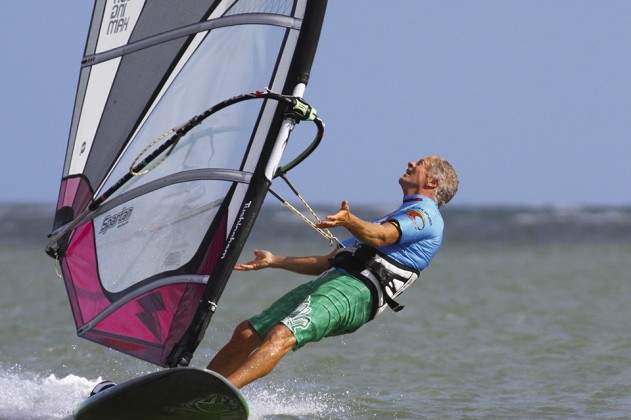PETER HART MASTERCLASS – FEELING THE PRESSURE(S)
Are you leaning in the right direction and pressing in the right places? Are you comfortable? Do you know what ‘comfortable’ feels like? Harty analyses the common set-up woes.
WORDS PETER HART // PHOTOS SIMON BASSETT & HART PHOTOGRAPHY
(This feature originally appeared in the August 2014 issue of Windsurf Magazine. To read more features like this first, Print and Digital subscriptions are available. Prices include delivery globally for 10 x issues a year!)
Back in the day every other article was about stance and set-up. Kit was random and transitory so there was a lot to talk about. But over decades, as rigs have softened, boards widened and rigging instructions become ever more precise, it’s now relatively easy to rig it right and drop into a serviceable stance … or so you would have thought. And yet I still get more questions about posture, trim and set-up than anything else.
I suspect it’s partly down to people reaching planing status much earlier and therefore with relatively little experience of kit and how a tweak effects feel and balance. It also has lot to do with the diversity of the sport. Last week at Neilson’s extensively equipped Vassiliki centre, one of my group was holding 2 boards from the same brand both around the 100-litre mark wondering which to use. They looked similar (both were green) but one (a Freemove) had a 40-cm. fin and the other (a Freestyle) had a 22-cm. fin. Such multiplicity offers huge opportunity for chronic mismatching and ensuing discomfort. So in an effort to sort this out once and for all, I’m going to look at the basic trim, set-up and loading issues – then see how they change for different board and rig types and disciplines. And, finally, in the tradition of all good workshop manuals, do a bit of trouble-shooting to discover how, if you are uncomfortable, why?
THE MEANING of COMFORT
‘Comfort’ is a nebulous concept for a sport, which encompasses a host of different sensations. The aim is to be comfortable for the aspect of performance at which your chosen combo is designed to excel. Different board and rig types will feel ‘comfortable’ at different times. All-round free-ride kit should feel fine on and off the plane and as you move into the straps, in nicely powered-up conditions. Slalom kit will only start to feel comfortable once you’re locked down and up to full, crazy speed. It’s pretty uncomfortable off the plane. Wave kit feels a bit weird in a straight line (straps too far apart and too inboard) but makes sense as you push and pull the board online in mid air and as you drop into carved turns. And freestyle kit feels comfortable … never, in my opinion … but sort of when you’re sliding backwards turned inside out. Most of the time ‘comfort’ isn’t the right word. Yes if you sail in the lee of a Polynesian atoll over the flattest water in a constant 16 knots of breeze on supremely tuned free-ride gear, you can achieve a state of glorious weightlessness where not one gram of effort is stressing your body. But, sailing fully maxed on slalom kit over wild chop, no matter how well set-up you are, ‘comfort’ isn’t the first word that pops into your head. However you should experience a feeling of balance, symmetry and efficiency.
TRIM, BALANCE, CHICKENS and EGGS
In sports involving balance and a variable environment, beware of people offering systems and fixed shapes. “Stand looking like a ‘7’ with load spread 60 to 40% in favour of the back foot,” is well meaning advice in that it asks you to stand tall and extend the arms, but it also encourages immobility. What happens when you get a gust or change course? Pressures change so we have to be reactive. It’s better to focus on the desired end product, which is to keep the rig still, deliver a constant source of power to the board and trim it level nose to tail and side to side. Then just do what you’ve got to do to maintain that angle through gusts and lulls and as you steer up or downwind.
Sounds a bit vague, but it gives you the scope to react instinctively. You have your three points of contact, back foot, front foot and mastfoot and you constantly adjust how you share the load between them to keep a steady trim. If the tail is sinking you shift load from the back foot to the mastfoot etc. It gets a little more complicated when you factor in speed and fin size and how much lift you get from the fin. However, if you react to sensations rather obey a formula, the movements should be also be instinctive.
And as you get better, you refine those movements, moving from front to back foot, heel to toe, to seek the perfect trim angle – slightly nose up or nose down, windward edge up or down – where the board makes the perfect contact and slides with no feeling of pushing water. BUT if the only way to achieve that perfect trim is to twist and contort to the point of torture, then you have an issue with your set-up and tweaks have to made.
THE BEAM REACH SYMMETRY TEST
Across the wind is the best way to test your set up as the loading is symmetrical. The key is to forget fixed shapes and systems and feel which way and how the rig is pulling and how you’re channelling that power.
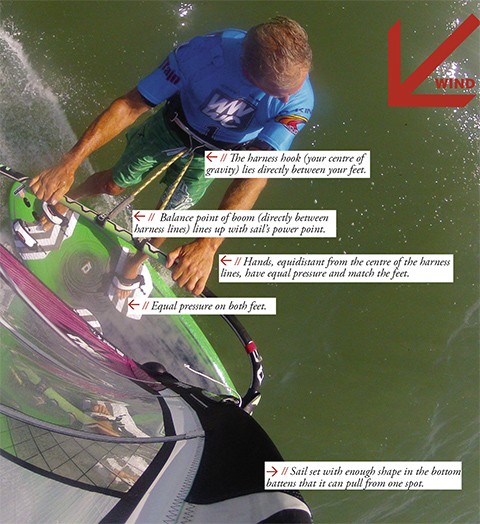
SIMPLE TESTS – beam reach symmetry
When you start your planing career, we grant you a few weeks of unfettered whooping and hollering. But then please … stop enjoying yourself, knuckle down and develop a feel for what’s going on. I suggest this simple test for which you will require an all-round planing board with a rig that is well within the recommended range. Also seek conditions with a minimum of variables, which will not throw you off balance or make you defensive – namely flat(ish) water and a constant wind, strong enough to release you fully onto the plane. (By the way, if you find such conditions, please let me know where.) Now set off at 90º to the wind (beam reach). Across the wind is the point of sail from where it’s easiest to monitor the pressures and where those pressures are most symmetrical. If all is well and the set up is good, as you arrive on the plane, you should look down (well actually you should never look down …but for this exercise you can) and see and feel the following.
> your harness hook lying between your feet, which means you’ll have equal pressure on both feet.
> Your hands, also loaded equally, will be equidistant from the centre of the lines and will match the feet – i.e., the front hand will lie directly above the front foot etc. You can release front and/or back hand without catapulting.
> Standing upright, your arms will be parallel to the water.
On a beam reach you have an easy symmetry. It’s like lining up with someone, linking hands and trying to pull each other over. You face them and drive back off both feet. On the board you have a feeling of your centre of gravity, your harness hook, lining up directly with the power source. All being well, you don’t have to do much. If you have to load one or other arm to sheet in or out, if the board wants to bear away or head up and you have to constantly pressure one leg. If there’s no way you could even dream of letting a hand go for even a Nano second, you have a kink in your set-up, which we will address shortly.
CHANGING PRESSURES
From the moment you step on a board all you’re doing is opposing the pressure in the sail. That basic concept doesn’t change just because you’re hooked in and in the straps on a fancy bit of kit. As you bear away, the wind blows from the rear quarter, the pull is more forward so you resist it by dropping the hips back towards the tail, bracing against a straight front leg and softening the back knee. The load initially moves about 60/40 in favour of the back foot but that changes depending on your speed relative to the wind. As you accelerate and the direction of the apparent wind moves forward, so the loading moves more 50/50. Turning upwind the pull in the sail moves right back and drops – so you oppose it by leaning the hips forward to drive your bodyweight into the mastfoot to hold the nose down. Don’t ask how fast forward you lean or how much weight goes on which foot. If you’re fully powered and have a big fin, it’s all back foot and your hips stay between the feet. With a small fin and/or less power, you use minimum back foot pressure and crank the hips as far forward as your spine permits.
Upwind sailing is the ultimate balancing act and the point of sail where comfort is most elusive. With a vastly reduced forward force in the sail it’s all too easy to get the pressures wrong and find yourself in contorted survival positions. Discomfort usually arises from overloading one foot, one hand, one side of the body. Referring back to a very old lesson can help you recover your form.
CEs and CLRs
If you learned to windsurf back in the day, you will have been taught about your Centre of Effort (CE) and Centre of Lateral Resistance (CLR). When the CE (the power point of the sail) lies over the CLR (the board’s pivot point, the daggerboard back then) you go straight. If you move the CE in front or behind the CLR, the board turns. When daggers retracted or disappeared altogether and boards planed, the CLR moved back and so we could angle the rig back and sail the board from the tail. A lot of planing discomfort arises simply from not lining your CE up with your CLR (it’s a good decade since I’ve quoted those famous acronyms – it feels marvellous). On that beam reach where everything is symmetrically loaded, the CLR lies right between your feet. Upwind it’s more complicated. Because you’re planing more slowly, there’s more board in the water and so the CLR moves forward, which is why it’s often more comfortable to twist the back heel forward in the strap or move it out of the strap altogether so your feet are driving directly against the board’s balance point – that’s what racers are looking to do all the time. Generally the more equal the loading between the feet, the more comfortable you are.
In general the more equal the loading between the feet, the more comfortable you are.
THE UPWIND COMFORT STRUGGLE
Upwind is where most suffer. If you’re balanced across the wind but not as you point, then it’s most likely a stance/technique issue. The same rules apply. You still want to keep the rig still and the board level. However, with the sail producing a lot less forward force and with the pressure dropping onto the back foot, you have to compensate by moving the hips forward and driving your bodyweight through the harness and into the mastfoot to hold the nose down. But how much depends entirely on the size of fin, type of board and how powered up you are. It’s a constant balancing act.
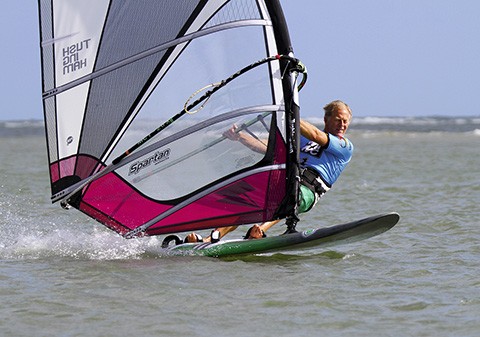
// Head and hips driving forward towards the mast in the upwind stance so you feel load at the front of the harness. It’s quite subtle. If you have to twist and agonise, you need to readjust.
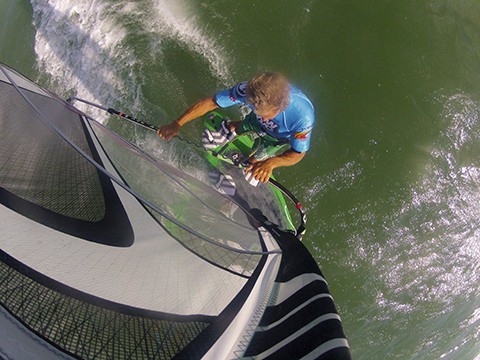
// Contorted misery here stems primarily from sailing too slowly. You need speed to make board rig settle. Slightly under-powered, the back foot is too far back and is stalling the tail. Rather than lean miles forward …
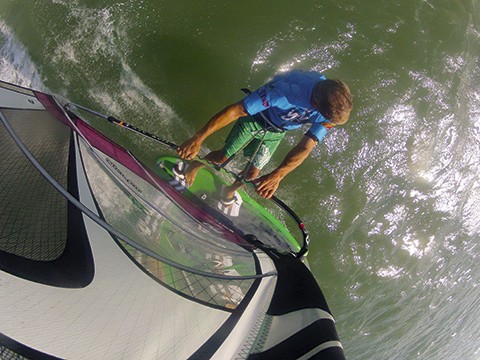
// … even up the pressures by moving the back foot forward of the strap.
DIFFERENT KIT – DIFFERENT FEELING
“I think I’m sailing OK but I’m not sure I know what ‘right’ feels like.” is a common reply to the questions “are you all right? Do you need to change something?” There’s no particular pain or imbalance, but a basic insecurity that they’re barking up a foreign tree. A typical example is when a dyed-in-wool blaster moves to manoeuvre-oriented kit. They’re used to the friction-less contact with the water you get from a hard-edged slalom board. On the freestyle wave board they’re not feeling that same slipperiness, nor the same reaction from the fin. They have to recognise how different design features effect the sensation under the feet. Boards with more curve in the outline, softer edges and more ‘V’ sit a little deeper in the water and don’t release quite in the same way (although are still very quick). But you come to appreciate those features as you bank into carved turns, when the board hugs the water and knifes through chop in a way that a slalom board doesn’t.
SPEED vs. MOBILITY
As you look to explore windsurfing’s diversity and feel comfort across more than one discipline, you fall upon two distinct set-ups and sensations of ‘ comfort’ – maximum power or maximum mobility. Lets examine the extremes:
At one end you are set up for a world record speed attempt on a 30-cm. wide speed board with a 20-cm. fin carrying a 5.5 in 45 knots. It’s all about getting the most amount of power to drive the smallest wettest surface. You have to go fast or the fin stops working. Hence you have to drive that power into exactly the right millimetre of the board. There is no room to move around. Any sudden trim change results in an immediate explosion.
At the other end you’re about to take freestyle in the waves to new levels. In 22 knots of wind you have a 90-litre freestyle wave board with a 20-cm. fin powered by a 4.2 sail (you’re extremely fit, young with a negative body fat index by the way). The lack of raw power from the small sail gives you maximum mobility. The power is easy to dump and control so you’re never a slave to it. Hence you can move easily in and out of the harness, taking up extreme positions leaning forward or back to dip, twist and turn into tricks.
“You must be joking!” is the common cry from the traditional rider befuddled by the alien sensation. You’re just standing over the board getting blown along (or actually NOT getting blown along since there appears to be so little power). With no fin to speak of, the only way to hold your line and sail upwind is to sail entirely off the front foot and use the heel to hold in the windward edge grip. The back foot is weightless. Not until you start popping and sliding does it make any sense.
LOADED ISSUES – a question without an answer
Here’s a message I received last week from Kristoffer in Norway that summarises the plight of many:
I have been windsurfing since 2001. Unfortunately I have considered quitting windsurfing since, well 2001. Here is why: I have never been able to adapt to a comfortable body position due to the fact that I’ve never learned how much weight goes on the front foot and how much weight goes on the back foot. Also I’ve never been able to figure out which way to lean! Should I be leaning backwards? 90 degrees from the board? All of this results in me using an awful amount of energy when I’m on the plane. Probably different answers depending on the reach, but I’m desperate for some help. I really want to
get comfortable!
The source of most loading issues is the kit which is not allowing you to settle into positions which others seem to adopt with ease. Get someone of similar stature whose style you admire to sail your kit and see if they have similar problems. If they plane away no handed and can’t see what the fuss is about, then change your approach to a more organic one. Feel where the sail is pulling from and line yourself up with the power. Be especially aware of yourself as the power distributor and sense what happens to the board trim as you move the hips towards the nose and tail and load the feet differently. And above all adhere to the 3 basics, commit to the harness, keep the rig still and the board flat.
LINE IMBALANCE
Misplaced lines are the root of massive discomfort and will corrupt your whole game. If you can’t sail with your hands in their normal places on the boom, something needs changing.
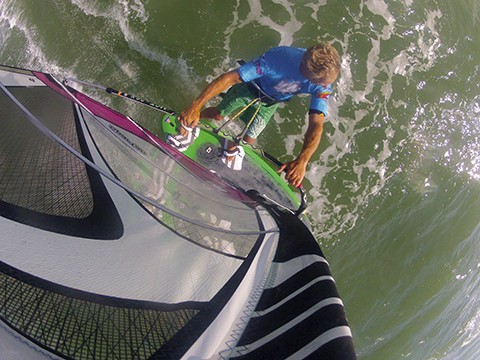
// The lines are too far back. The front hand is loaded up and has to move forward to hang on and avoid a catapult, at which the load gets transferred to the front foot and you bear away involuntarily.
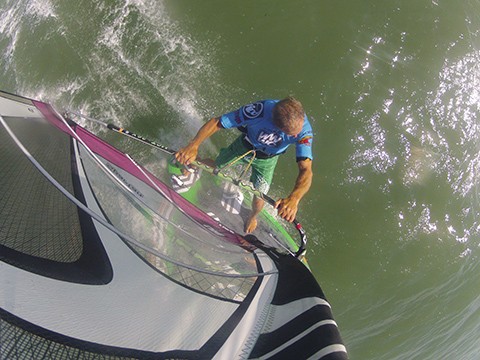
// To restore balance the feet will want to match the hand position and the wheels fall off completely.
SHOOTING THE TROUBLES
Lets split the common troubles into set-up and pilot issues – starting with the latter.
Human error
These are things you can blame on no one else but yourself
Speed. The number one reason for general discomfort on all types of board is lack of speed. If the board is sort of half planing, displacing water and pitching into chop, the balance point moves back and forth. Without much apparent wind, the rig feels every change in the real wind. It’s a scenario that forces you into perpetual motion. The instant cure is to commit more to the harness and bear away. With speed both board and rig become more stable.
Comfortable on one tack but not the other.
Here’s a desperate email from Greg who’s been windsurfing for 18 months.
On a port tack, I can get both feet in straps and be fully hiked out and the sail feels balanced. But going the other way it feels like the CE is further forward and I have to lean towards the front of the board to balance the pull of the sail … I am just like “Aaaarrrrrgggghhh!!!!” I can’t understand how it can be rigged fine one way and not the other.
Asymmetric discomfort is an interesting riddle. First you check rigging. Does the sail rotate and are the lines the same on both sides? Is it a stance issue? People who are especially one handed tend to oversheet when their strong hand is their back hand. Conversely when it’s their front hand, they tend to bend it, choke the rig and sheet out. But often it’s just tactical. What Greg is describing on his bad side, is a stance where he’s trying to sail too close to the wind with not enough speed. It’s quite common. When people leave the beach, they often sail broader to the wind than they realise especially if they’re heading for a blank horizon or a lee shore with no distinguishable landmarks. Sailing off wind, the board releases easily, gets up to full speed and feels hunky-dory. But when they turn, they instinctively point straight at their launch spot, which is now upwind. They never really get going and, as I described above, sailing without speed, especially upwind, is about as uncomfortable as it gets. The cure is to bear away to get fully planing, even though it means heading below your goal, and then use that speed to carry you upwind.
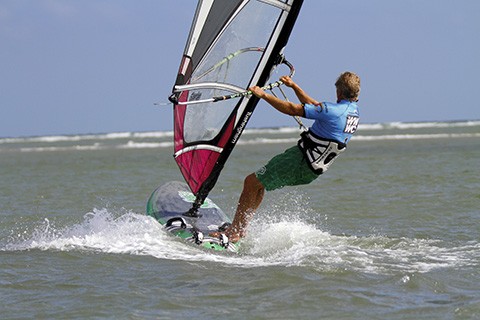
// If the boom height is comfortable the arms are parallel with the water, the harness line is coming out at 90º to the body, you feel lined up with the power and can use toes to trim the board level. If it’s too high you keep pulling the rig down to windward and drop onto your heels.
Rigging errors
The crisis that befalls many comfort-seeking windsurfers is one of confidence. They rig according to instructions. It doesn’t feel right – it therefore must be them. (And you know what? It might be.) However, to have reached the stage where you are planing, you are already a good windsurfer. You have feelings and you must trust those feelings to the point of saying: “I don’t care what the book says, I don’t feel comfortable and I’m going to change something” The question is what? This may sound like a ridiculous use of your time but when you have nothing better to do, mess around with the extremes of your adjustment options. Put the boom right up – and then right down. Let the downhaul off and then overdo it and do the same with the outhaul. Slide the mastfoot to the front and back of the track – so you can relate each tweak to a new sensation and feel how it effects the power and your ability to channel it.
Harness lines never feel right
Harnesses lines are the messengers. Don’t shoot the messengers. Ok yes if one hand is constantly overloaded then the line is imbalanced and you need to move it towards the aching limb. But if the lines never feel right, you know the rig’s power point is moving around. And without a constant source of power, you will never be comfortable. It could be many things but the main one is:
Too much/too little outhaul. The outhaul controls the shape in the bottom half of the sail. If you flatten it off too much the wind just bounces off it. As the gust hits, the rig shakes between your hands. The power can’t settle and pull from one spot.
With too little outhaul, there’s lots of shape (and pull) but with no tension in the back of the sail, the shape can move back and forth depending how hard you sheet in. Basically anything that makes the rig unstable – wrong outhaul and downhaul tensions, wrong mast match – will make the lines feel wrong.
Can’t get off the back foot.
Foot pressure reflects hand pressure, so that anything that loads up the back hand – lines too far forward, too full a sail – will load up the back foot. An over-high boom forces you onto the back foot as does trying to load too small a board with too big a rig.
If on your beam reach you look down and see the harness hook over your back foot, you know you’re in trouble. Moving the mastfoot forward can help – but only a little. The board rig match is the biggest issue. Recently a guy with comfort problems handed me his 125 loaded with an 8.0 – all good kit, well rigged and the sail was within the recommended range, albeit at the top. I could make it work by employing old racing strategies of bearing right off and sailing really fast, but as soon as I slowed down a little, it felt horrible. The fin was a little too small. A slower speeds it lost lift and grip. And as the tail crabbed sideways, you fell against the back foot. We tried a 7.5 and balance was immediately restored between the feet.
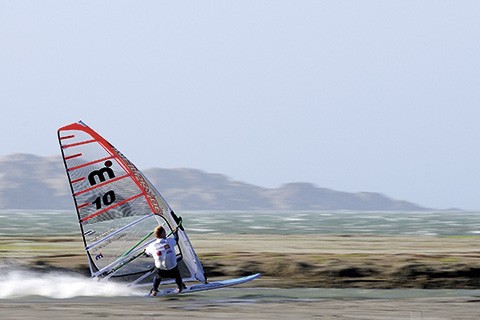
// Anders Bringdal, flirting with 50 knots, is a study of calm symmetry. He’s on a very broad reach but he’s still perfectly lined up between the feet with equal loading – the most comfortable and efficient stance.
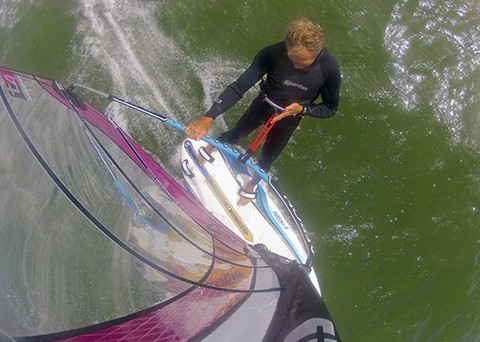
// The ‘mono-line’ isn’t everyone’s cup of tea but it’s makes you acutely sensitive to where the sail is pulling from. Posey it may be – but releasing one or both hands IS the best way of testing the balance of your set-up.
Constant, unwanted force in the arms and … everywhere.
Assuming you’re committing to the harness, the culprit is usually a ‘draggy’ sail, which is catching the wind but not releasing it. More downhaul allows the leech to open and softens the whole feeling. A lack of outhaul can also make a sail feel ‘pully.’ John from Holland had a life-changing moment on a recent clinic. He said he could never sail for more than an hour without his arms giving out. He rigged the sail as you should, plenty of downhaul. His stance was fine. But it wasn’t until I sailed right behind him that I noticed his boom was unnecessarily high. He wasn’t a heavyweight so didn’t need it for early planing. He didn’t know why. It was something he was once told to do and he got used to it. We lowered it to just under shoulder, the load went from his arms and he sailed all afternoon without the hint of a blister. Like your driving style, boom height is so personal that people are loth to criticise. But it can be incredibly disruptive. A trend within freestyle prompted many to put them up. Yes it does help early planing but not if you overdo it. A basic inability to hold a steady trim and posture through gusts and lulls is often down to a lofty boom. You’re pulling down on the boom, so when a gust hits, you get pulled upright onto your toes, so you have no choice but to sink back and pull it to windward, at which point your drop onto your heels and sink the windward edge = lots of movement and trim changes and rare moments of balance and comfort.
Check the angle of the harness line when you’re hooked in. If it’s angled at 45º to your body, you have a problem. With a lower boom where your arms lie parallel to the water and where the lines come out at 90º to the body, you pull directly against the power and can hold a steady position.
Next month Peter addresses the Daddy of all technique subjects, how to achieve the first planing carve gybe. If you want a heads up on the subject you can order his acclaimed new DVD ‘Ten Steps to Gybing’ by emailing
[email protected]. To nab one of the few places left on his 2014 clinics go to www.peter-hart.com or ‘like’ his Peter Hart Masterclass Facebook page.

